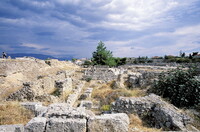| dc.coverage.spatial | Site: Corinth, Peloponnese, Greece | en_US |
| dc.coverage.temporal | ca. 680 BCE-175 CE (creation) | en_US |
| dc.creator | unknown (Greek (ancient)) | en_US |
| dc.date | -680-175 | en_US |
| dc.date.accessioned | 2013-03-20T18:04:27Z | |
| dc.date.available | 2013-03-20T18:04:27Z | |
| dc.date.issued | -680-175 | en_US |
| dc.identifier | 202189 | en_US |
| dc.identifier.other | archrefid: 1098 | en_US |
| dc.identifier.uri | http://hdl.handle.net/1721.3/109951 | |
| dc.description | Agora, general view of the Roman shops, looking east; The first evidence of monumental stone architecture is a sanctuary of Apollo erected ca. 680 BCE at the centre of the city. The temple of the sanctuary had no peristyle but did have a tiled, hipped roof. Between 580 and 540 BCE it was replaced by a temple (now ruined) in the developed Doric style. Corinth was well known for its fountains, many of which were restored in the Roman period. Lower Peirene was of more than local renown. Originally a spring gushing from a cliff face, it was altered through the years into a fountain-house with four long reservoirs, from which the water flowed into drawbasins. The Romans re-established the cult of Aphrodite on Acrocorinth. The Temple of Apollo, the fountain-house of Lower Peirene and the south stoa were reused by the Romans but drastically altered. Podium temples dedicated to Aphrodite, Apollo and Tyche lined the west side of the forum, with a central space allowing access to the west shops behind and Temple E above them and beyond. The city had an odeion (late 1st century CE, rebuilt 175 CE) and an amphitheatre that served for public entertainment. Source: Grove Art Online; http://www.groveart.com/ (accessed 1/27/2008) | en_US |
| dc.format.medium | stone | en_US |
| dc.rights | © Scott Gilchrist, Archivision, Inc. | en_US |
| dc.subject | architectural exteriors | en_US |
| dc.subject | Roman Empire | en_US |
| dc.subject | Greek (ancient) | en_US |
| dc.subject | Imperial (Roman) | en_US |
| dc.subject | Hellenistic | en_US |
| dc.title | Corinth [Ancient Greek and Roman site] | en_US |
| dc.type | image | en_US |
| dc.rights.access | Licensed for educational and research use by the MIT community only | en_US |
| dc.identifier.vendorcode | 1A3-G-C-H2 | en_US |
| vra.culturalContext | Greek (ancient) Ancient Roman | en_US |
| vra.technique | construction (assembling) carving (processes) | en_US |
| vra.worktype | excavation (site) | en_US |
| vra.worktype | temple | en_US |
| vra.worktype | agora | en_US |
| dc.contributor.display | unknown (Greek and Roman (ancient)) | en_US |


